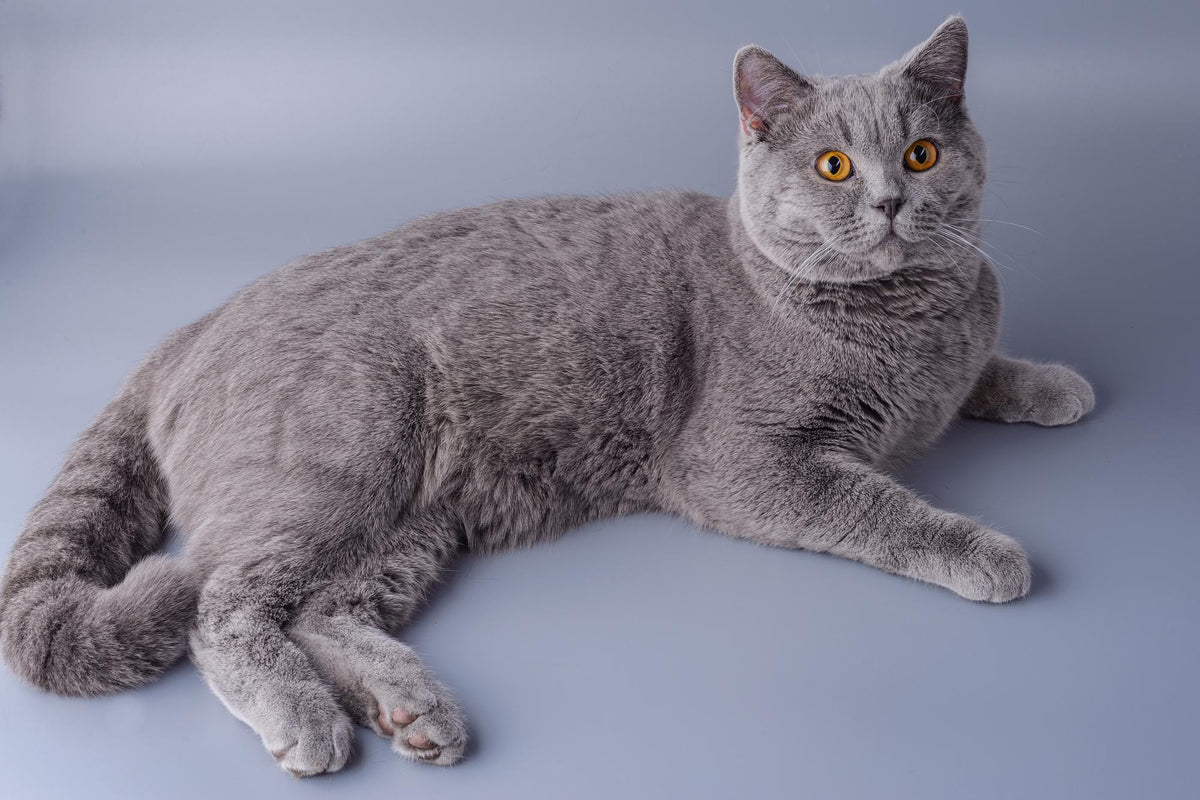British Shorthair: An Elegant and Endearing Cat

The British Shorthair is a highly popular cat breed, both in its country of origin and across the Channel, as well as in many other countries. This cat, with its dense coat and teddy bear-like appearance, is loved for its balanced and endearing character. Suitable for family life, it knows how to show affection while maintaining a certain independence.
- Origins and History
- Physical Characteristics
- Character and Behavior
- Care and Hygiene
- Nutrition
- The British Shorthair at a Glance
Origins and History

The ancestors of the British Shorthair were cats that had adapted to the harsh climatic conditions of the British Isles, developing a dense coat to protect them from the elements and the cold. Harrison Weir, one of the English pioneers of cat breeding, played a key role in the development of the British Shorthair. He founded the National Cat Club and organized the first cat show in London in 1871, where a female of the breed was successfully exhibited.
The two World Wars nearly led to the extinction of the British Shorthair. After 1945, many breeders crossed them with Persians, Russian Blues, and Chartreux to rebuild the population. Today, the British Shorthair is one of the most popular cats in the United Kingdom.
Physical Characteristics
- Body: Semi-cobby, short and strong, with well-developed musculature.
- Coat: Short and dense, with a woolly texture.
- Coat Colors: All colors are allowed.
- Head: Round with full cheeks.
- Eyes: Large, round, with a lively and friendly expression.
Character and Behavior
Thanks to its balanced temperament, the British Shorthair is a pleasant companion for all family members. It is very attached to its owners but retains a certain independence. It knows how to be discreet and rarely meows. While not entirely inactive, it is very calm and shows its athletic abilities when playing or exploring its environment.
Intelligent, friendly, and curious, it gets along well with children and does not shy away from strangers, which can also be a disadvantage in the presence of ill-intentioned people.
Living Conditions
The British Shorthair adapts to all living conditions, whether urban or rural. It seeks comfort and security in its home but also needs some freedom. Ideally, it should have access to a secure outdoor area where it can express its exploratory desires. It can also learn to walk on a leash with a harness for better tension distribution.
Care and Hygiene

Caring for the British Shorthair is not particularly difficult but should not be neglected. A thorough brushing each week is recommended, becoming daily during shedding periods to remove as many dead hairs as possible. Care also includes cleaning around the eyes and ears, trimming the claws, and brushing the teeth. The British Shorthair is generally robust, but the breed is prone to certain diseases such as polycystic kidney disease (PKD) and feline hypertrophic cardiomyopathy (HCM). Polycystic kidney disease is characterized by the formation of cysts in the kidneys, leading to kidney failure over time.
The British Shorthair has a life expectancy of 15 to 20 years.
Nutrition
Due to its tendency to be less active and its love of food, the British Shorthair is at risk of obesity. Its diet should be rich in high-quality proteins and low in fats. Supplements may be given on the advice of a veterinarian.
Nutritional Needs
The British Shorthair has specific nutritional needs to maintain optimal health:
- High-Quality Proteins: Proteins are essential for muscle development and overall health. Opt for protein sources such as chicken, fish, or lamb.
- Healthy Fats: Fats provide energy and contribute to healthy skin and coat. Omega-3 and Omega-6 fatty acids are particularly beneficial.
- Fiber: Fiber aids digestion and maintains good intestinal health. Vegetables and whole grains are good sources of fiber.
- Vitamins and Minerals: A balanced diet should include vitamins and minerals to support the cat's immune system and overall health.
It is important to choose a diet that is appropriate for its age, weight, and activity level. Always consult a veterinarian for personalized advice.
Treat Recommendations
To complement your British Shorthair's diet, Marly & Dan offers a range of premium treats tailored to your feline companion's needs. Here are some of the most recommended options:
- Hairball Treats: Enriched with natural fibers and enzymes, they help the ingested hair pass through the digestive system, reducing vomiting and discomfort.
- Skin & Coat Treats 100% Salmon: A high-quality protein source, supporting healthy skin and a shiny coat.
- Salmon Oil: Rich in Omega-3 and Omega-6, it is a top-quality supplement that contributes to skin health and coat shine in cats.
Marly & Dan treats are made in France with natural and high-quality ingredients, ensuring healthy and tasty snacks for your British Shorthair. Give them the best by choosing Marly & Dan, a brand dedicated to excellence in animal nutrition.
Price and Budget
The purchase price of a British Shorthair ranges between €400 and €1800. The annual maintenance cost varies between €200 and €400.
The British Shorthair at a Glance
FAQ
The British Shorthair enjoys cuddling, but on its own terms. It is not the type of cat that constantly seeks attention. It appreciates moments of affection but also values its independence. It is a balanced companion that can be both aloof and affectionate.
Yes, the British Shorthair sheds, especially during the shedding seasons in spring and fall. Regular brushing helps control hair loss and keeps its coat healthy.
Yes, the British Shorthair adapts very well to apartment living. However, it will also appreciate access to a secure outdoor area where it can explore safely. Be sure to provide enough mental and physical stimulation to prevent boredom.


